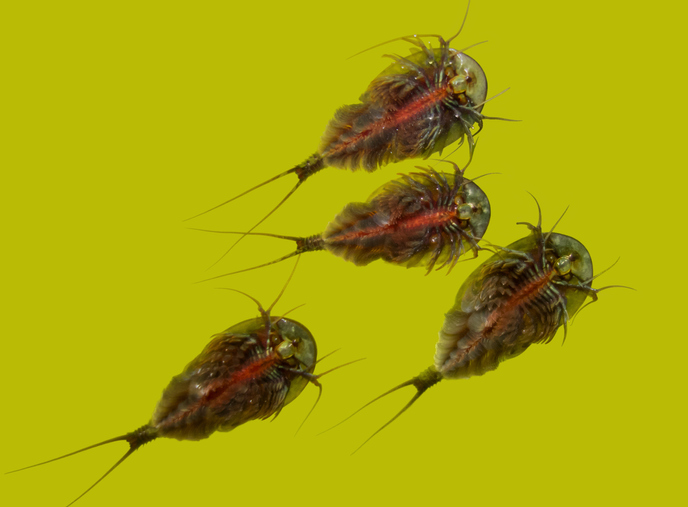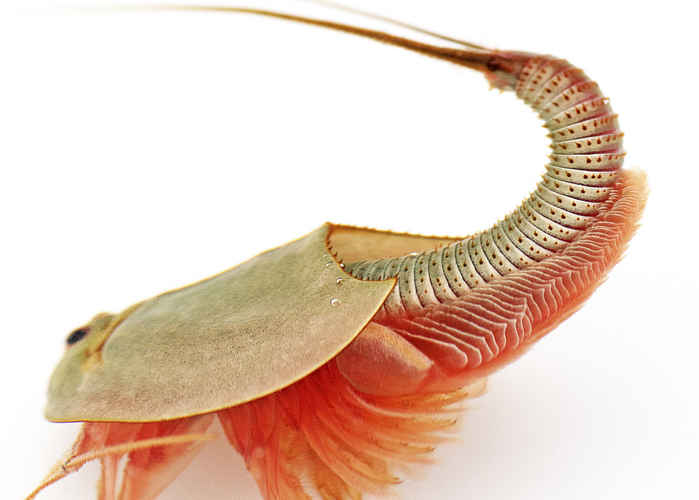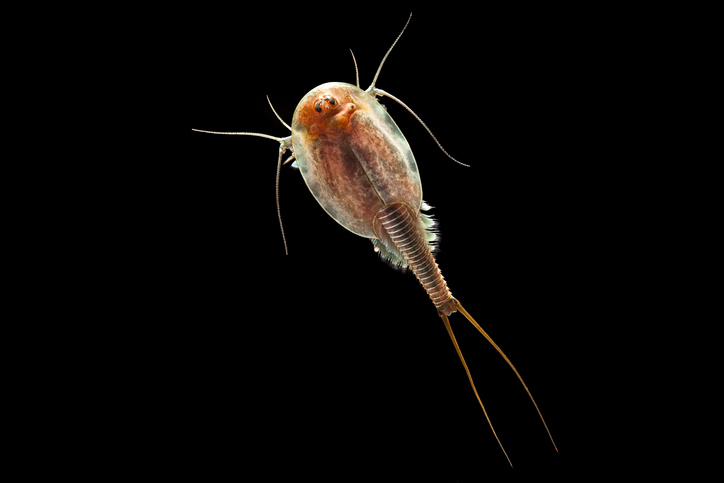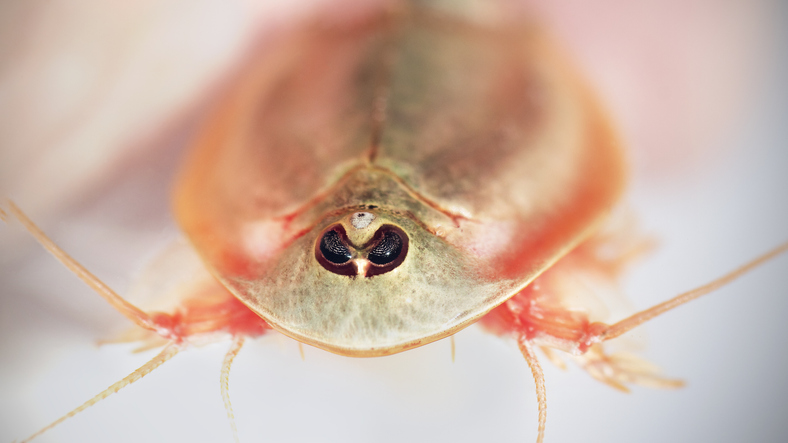Triops - keeping and breeding primeval crabs
The Triops, which have remained practically unchanged since the time of the dinosaurs, live in nature in temporary bodies of water that develop quickly and dry out again quickly. The animals therefore only have a few weeks for their complete life cycle - they then form permanent eggs that remain fertile for a long time. Even a dry period of 20 years is no problem! The permanent eggs need a drying phase. When they are returned to the water, the nauplii hatch.
What kind of water do Triops need?
Triops thrive best in soft tap water, which should be well stagnant, with water conditioner that eliminates heavy metals and the like. Osmosis water, Volvic or rainwater filtered with activated carbon are also best for Triops breeding. In these cases, you should add some GH+ hardening salt for shrimp to provide the animals with the necessary minerals.
 Stock-Fotografie-ID:1293313412
Stock-Fotografie-ID:1293313412
Breeding Triops
For breeding, put about 5 cm of distilled water and the sand-egg mixture into a two-litre container. Place the container in a bright spot, but not in direct sunlight. About 80% of the nauplii will hatch after two to three days, 2% within two weeks, the rest will remain in the egg and will only hatch after one or several more dry phases. When the first nauplii are on their way, increase the water level by about 10% daily.
When the little Triops are about 2-3 cm long, they are transferred to their aquarium. Before you do this, change the water in the rearing tank by about 50% and fill it up with aquarium water so that the animals can get used to the new values. When transferring the animals, make sure that the water temperatures are approximately the same or slowly adjust the animals to the new conditions.
 Stock-Fotografie-ID:979558936
Stock-Fotografie-ID:979558936
Feeding Triops correctly
In the wild, small Triops mainly eat algae and protozoa, larger specimens from about 1-2 cm in length feed on detritus, plant fibres and tiny crustaceans such as ostracods or copepods. They also do not say no to worms. Unfortunately, it cannot be completely ruled out that Triops also eat each other.
From the second day of life - when the larvae have switched over to bottom life - carefully feed chlororella powder in tiny amounts, a toothpick tip of powder is enough. Do not feed again until all the food has been eaten. If too much food causes a film to form, remove it with a Zewa cloth to ensure gas exchange at the water surface.
In the aquarium, it is best to feed special Triops food after the initial period. Feed them rearing food when they are between 2 and 4 weeks old, then you can switch to main food. A cichlid food with a high animal content is also very popular with the Triops and they tolerate it very well.
 Stock-Fotografie-ID:176772828
Stock-Fotografie-ID:176772828
Setting up the Triops aquarium correctly
A Triops aquarium doesn't necessarily need plants, but it can't do without substrate. The crayfish are incredibly fond of digging and have a significantly shortened lifespan in bare tanks, presumably due to stress that occurs when they cannot follow their natural behaviour. A fine substrate of 1-2 mm grain size and 2-3 cm height has proved successful, sand or fine natural gravel is the medium of choice here. Gravel coated with plastic is not so suitable because of the high abrasion caused by the Triops' digging.
Root wood and stones as decoration in the aquarium also work very well with Triops. Soft-leaved plants are eaten very readily, but Anubias or similar less palatable plants have a chance. However, a Triops aquarium without plants is no problem.
No technical equipment for Triops?
A filter is not necessary for keeping Triops, the prehistoric crustaceans do well in a filterless aquarium, provided you change about 50% of the water weekly. If you prefer to run an aquarium with a filter for your Triops, you should use a sponge filter with an air lift. Here nothing can happen to the crayfish, even if they should find their way into the filter.
The cycle begins again
When the large Triops have reached the end of their life and die, let the aquarium continue to run as usual for about 14 days - but without feeding them. This allows the cysts to develop well. Then drain most of the water. Now let the sand dry out slowly at room temperature - be careful, this can stink quite a bit, so it's best to put the tank outside for the time being! When the sand is completely dry, you can start the next Triops batch.
Popular species of Triops for the aquarium
Triops longicaudatus
These prehistoric crustaceans come from America. The Longis need it warm, they grow accordingly fast and behave quite lively. Triops longicaudatus reach sexual maturity within two weeks, then they already start laying eggs. These Triops need it cosy: a water temperature of about 24-28 °C is mandatory. They need very soft water. Triops longicaudatus are shimmering grey in colour. They grow to 5-7 cm in length, have a strikingly long tail and live to about 60-90 days.
 Stock-Fotografie-ID:998678216
Stock-Fotografie-ID:998678216
Triops longicaudatus "Red
This colour form is the albino variant of Triops longicaudatus from America. The great bright red colouring is due to the red blood shining through the transparent carapace. In terms of keeping conditions, there is no difference to the wild-coloured Triops longicaudatus.
Triops cancriformis
The summer shield crayfish Triops cancriformis, native to Europe, is ideal for beginners in keeping ancient crayfish. Triops cancriformis have a relatively short tail and look a bit beefier. They grow to a length of 4-6 cm.
This rather robust, somewhat smaller Triops tolerates cooler temperatures of 22-24 °C very well. Besides soft water it also tolerates medium hard water. Triops cancriformis becomes sexually mature within two weeks. In addition to permanent eggs, the females also lay a few instant cysts from which nauplii hatch without a resting phase. Triops cancriformis grow a little older than other species with 90 to 120 days. They are also less cannibalistic.
Different local variants of Triops cancriformis are often available, which differ slightly in appearance and colour. For example, a local form from Brandenburg / Germany is rather brownish-reddish in colour, while a local form from Austria is rather greenish-brown.
Triops cancriformis "Beni Kabuto ebi Albino"
Despite the Japanese name, this is an albino form of the European Triops cancriformis, but bred in the aquarium. The red blood shines through their transparent carapace, so these primeval crabs have a beautiful bright red colour. The carapace can look slightly marbled.
